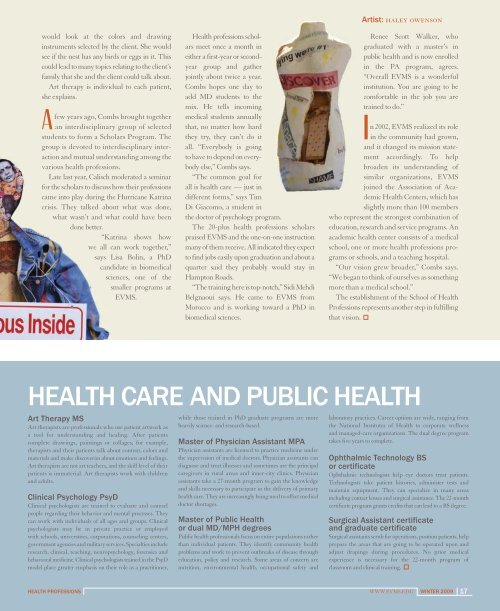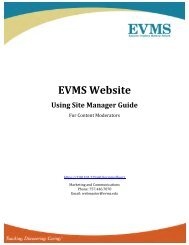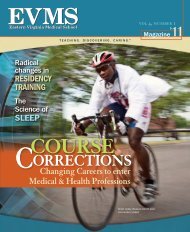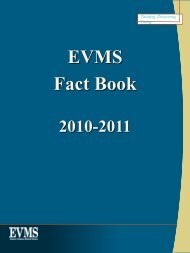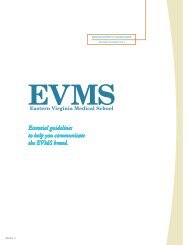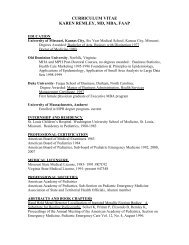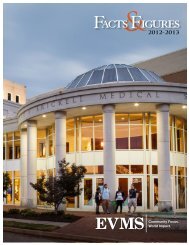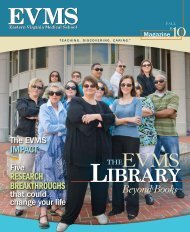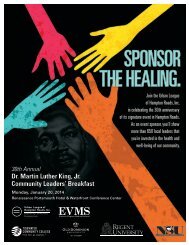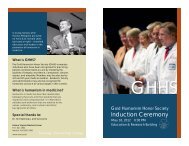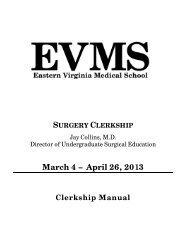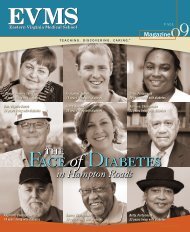Magazine - Eastern Virginia Medical School
Magazine - Eastern Virginia Medical School
Magazine - Eastern Virginia Medical School
Create successful ePaper yourself
Turn your PDF publications into a flip-book with our unique Google optimized e-Paper software.
would look at the colors and drawinginstruments selected by the client. She wouldsee if the nest has any birds or eggs in it. Thiscould lead to many topics relating to the client’sfamily that she and the client could talk about.Art therapy is individual to each patient,she explains.Afew years ago, Combs brought togetheran interdisciplinary group of selectedstudents to form a Scholars Program. Thegroup is devoted to interdisciplinary interactionand mutual understanding among thevarious health professions.Late last year, Calisch moderated a seminarfor the scholars to discuss how their professionscame into play during the Hurricane Katrinacrisis. They talked about what was done,what wasn’t and what could have beendone better.“Katrina shows howwe all can work together,”says Lisa Bolin, a PhDcandidate in biomedicalsciences, one of thesmaller programs atEVMS.Health professions scholarsmeet once a month ineither a first-year or secondyeargroup and gatherjointly about twice a year.Combs hopes one day toadd MD students to themix. He tells incomingmedical students annuallythat, no matter how hardthey try, they can’t do itall. “Everybody is goingto have to depend on everybodyelse,” Combs says.“The common goal forall is health care — just indifferent forms,” says TimDi Giacomo, a student inthe doctor of psychology program.The 20-plus health professions scholarspraised EVMS and the one-on-one instructionmany of them receive. All indicated they expectto find jobs easily upon graduation and about aquarter said they probably would stay inHampton Roads.“The training here is top-notch,” Sidi MehdiBelgnaoui says. He came to EVMS fromMorocco and is working toward a PhD inbiomedical sciences.Artist: haley owensonRenee Scott Walker, whograduated with a master’s inpublic health and is now enrolledin the PA program, agrees.“Overall EVMS is a wonderfulinstitution. You are going to becomfortable in the job you aretrained to do.”In 2002, EVMS realized its rolein the community had grown,and it changed its mission statementaccordingly. To helpbroaden its understanding ofsimilar organizations, EVMSjoined the Association of AcademicHealth Centers, which hasslightly more than 100 memberswho represent the strongest combination ofeducation, research and service programs. Anacademic health center consists of a medicalschool, one or more health professions programsor schools, and a teaching hospital.“Our vision grew broader,” Combs says.“We began to think of ourselves as somethingmore than a medical school.”The establishment of the <strong>School</strong> of HealthProfessions represents another step in fulfillingthat vision.HEALTH CARE AND PUBLIC HEALTHArt Therapy MSArt therapists are professionals who use patient artwork asa tool for understanding and healing. After patientscomplete drawings, paintings or collages, for example,therapists and their patients talk about content, colors andmaterials and make discoveries about emotions and feelings.Art therapists are not art teachers, and the skill level of theirpatients is immaterial. Art therapists work with childrenand adults.Clinical Psychology PsyDClinical psychologists are trained to evaluate and counselpeople regarding their behavior and mental processes. Theycan work with individuals of all ages and groups. Clinicalpsychologists may be in private practice or employedwith schools, universities, corporations, counseling centers,government agencies and military services. Specialties includeresearch, clinical, teaching, neuropsychology, forensics andbehavioral medicine. Clinical psychologists trained in the PsyDmodel place greater emphasis on their role as a practitioner,while those trained in PhD graduate programs are moreheavily science- and research-based.Master of Physician Assistant MPAPhysician assistants are licensed to practice medicine underthe supervision of medical doctors. Physician assistants candiagnose and treat illnesses and sometimes are the principalcaregivers in rural areas and inner-city clinics. Physicianassistants take a 27-month program to gain the knowledgeand skills necessary to participate in the delivery of primaryhealth care. They are increasingly being used to offset medicaldoctor shortages.Master of Public Healthor dual MD/MPH degreesPublic health professionals focus on entire populations ratherthan individual patients. They identify community healthproblems and work to prevent outbreaks of disease througheducation, policy and research. Some areas of concern arenutrition, environmental health, occupational safety andlaboratory practices. Career options are wide, ranging fromthe National Institutes of Health to corporate wellnessand managed-care organizations. The dual degree programtakes five years to complete.Ophthalmic Technology BSor certificateOphthalmic technologists help eye doctors treat patients.Technologists take patient histories, administer tests andmaintain equipment. They can specialize in many areasincluding contact lenses and surgical assistance. The 22-monthcertificate program grants credits that can lead to a BS degree.Surgical Assistant certificateand graduate certificateSurgical assistants scrub for operations, position patients, helpprepare the areas that are going to be operated upon andadjust drapings during procedures. No prior medicalexperience is necessary for the 22-month program ofclassroom and clinical training.HEALTH PROFESSIONSWWW.EVMS.EDU WINTER 2009 17


